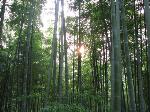
A Little Bit About Dazhuhai
The quiet road is edged with small, allotment-like pieces of land on one side and bamboo on the other. It is a pleasant 10-minute walk to the entrance of Dazhuhai and it is past 5pm when I arrive. The huge car-park has emptied apart from a few cars and I am content to find myself here at the closing of the day, the crowds having long since returned “ashore” to their comfortable coaches.Established in 1999, Dazhuhai is the biggest bamboo forest park in the South East of China and covers an area of just under 19km2. It remains “under development” in terms of plans to increase its forest walkways which are currently quite limited. Dazhuhai still sells itself heavily on its part in Chinese director Ang Lee’s epic movie “Crouching Tiger, Hidden Dragon” and rightly so. The first Chinese movie ever to win Oscars, this sweeping story is filmed against a landscape that is equally compelling: the splendid scenery as unforgettable as the film. The spectacular “flying” fight scenes in the impossibly tall bamboos were filmed here and as I walk beneath this sussurating forest I reflect that the hypnotic beauty of bamboo deserves its place on the big screen alongside that of Zhang Ziyi or Chow Yun Fat.The Story of Five Woman SpringThe spring itself flows into a stream that runs down the right-hand side of the main path. It is edged by a covered walkway of paths and pergolas and opens out near the entrance of Dazhuhai into a small, shallow pond with stepping-stones.Five Woman Spring (Wunv quan, 五女泉), like many watercourses in China, has a story to tell. A long time ago, there were five peasant women. Every day the women would come down to the water to wash their clothes and talk together. The women felt that their fellow human beings were poor in heart and mind and so the five women planted some bamboo. Bamboo represents peace, harmony and spirituality in the Buddhist religion and so the women hoped to give their fellow people a place of beauty and contemplation to help heal their spirits. The Buddhist Goddess of Mercy, Guanyin (观音) saw what the five women did and was so moved by their efforts and goodwill that she transformed them into immortals and gave each of them a special name. One of the women she named “White Tea” (Baicha, 白茶). White Tea is a special kind of green tea that only grows in certain areas around Zhejiang and Fujian Provinces (福建省), so called because of the fine white hairs upon the leaf. It is believed that the perfect cup of White Tea can only be made using water collected from this spring. Water from this spring is also supposed to bring good fortune and blessings to those who drink it.
The quiet road is edged with small, allotment-like pieces of land on one side and bamboo on the other. It is a pleasant 10-minute walk to the entrance of Dazhuhai and it is past 5pm when I arrive. The huge car-park has emptied apart from a few cars and I am content to find myself here at the closing of the day, the crowds having long since returned “ashore” to their comfortable coaches.Established in 1999, Dazhuhai is the biggest bamboo forest park in the South East of China and covers an area of just under 19km2. It remains “under development” in terms of plans to increase its forest walkways which are currently quite limited. Dazhuhai still sells itself heavily on its part in Chinese director Ang Lee’s epic movie “Crouching Tiger, Hidden Dragon” and rightly so. The first Chinese movie ever to win Oscars, this sweeping story is filmed against a landscape that is equally compelling: the splendid scenery as unforgettable as the film. The spectacular “flying” fight scenes in the impossibly tall bamboos were filmed here and as I walk beneath this sussurating forest I reflect that the hypnotic beauty of bamboo deserves its place on the big screen alongside that of Zhang Ziyi or Chow Yun Fat.The Story of Five Woman SpringThe spring itself flows into a stream that runs down the right-hand side of the main path. It is edged by a covered walkway of paths and pergolas and opens out near the entrance of Dazhuhai into a small, shallow pond with stepping-stones.Five Woman Spring (Wunv quan, 五女泉), like many watercourses in China, has a story to tell. A long time ago, there were five peasant women. Every day the women would come down to the water to wash their clothes and talk together. The women felt that their fellow human beings were poor in heart and mind and so the five women planted some bamboo. Bamboo represents peace, harmony and spirituality in the Buddhist religion and so the women hoped to give their fellow people a place of beauty and contemplation to help heal their spirits. The Buddhist Goddess of Mercy, Guanyin (观音) saw what the five women did and was so moved by their efforts and goodwill that she transformed them into immortals and gave each of them a special name. One of the women she named “White Tea” (Baicha, 白茶). White Tea is a special kind of green tea that only grows in certain areas around Zhejiang and Fujian Provinces (福建省), so called because of the fine white hairs upon the leaf. It is believed that the perfect cup of White Tea can only be made using water collected from this spring. Water from this spring is also supposed to bring good fortune and blessings to those who drink it.
No comments:
Post a Comment